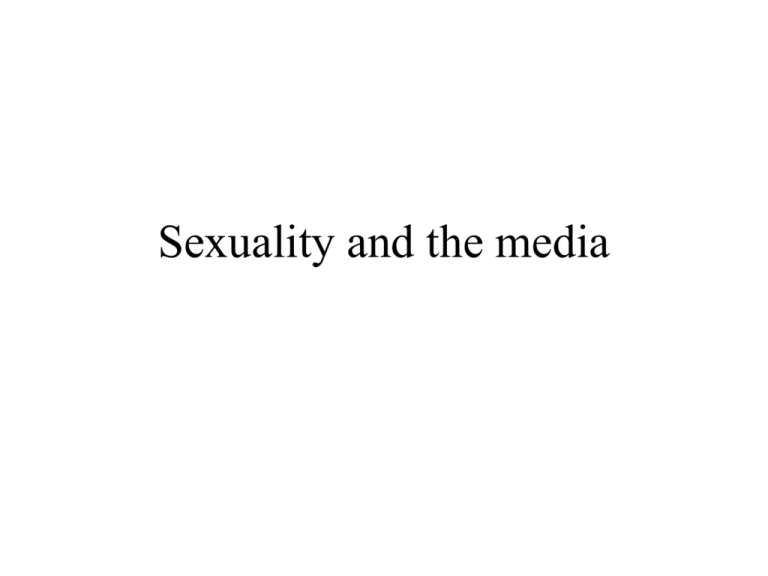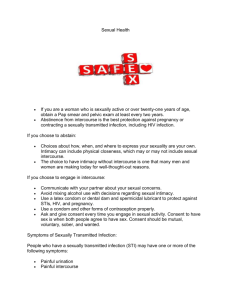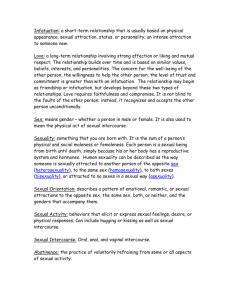
Sexuality and the media
American culture
• Sexuality is less accepted than violence
Why?
• Negative effects of sex
– However, violence certainly has its negative
effects
• “Puritan” morality
– More apparent than real
• Belief in the innocence of children
• “A TV network censored a sequence of
John Steinbeck’s The Red Pony, which
showed a mare giving birth, but broadcast
the rather hideous sequence from The
Godfather showing a beheaded horse.”
• “We now arrive at what turns out to be—
possibly through a kind of default—the
most pervasive and consistent influence
upon youth in the area of sexuality—the
mass media.”
– Internet campus
• “Each year, a typical teen-ager views nearly
15,000 sexual references, innuendoes and
jokes on television, of which fewer than 170
deal with abstinence, birth control, sexually
transmitted diseases or pregnancy.” (CNN)
Television exposes children to adult
behaviors, like sex. But it usually does not
show the risks and results of early sexual
activity. On TV, sexual activity is shown as
normal, fun, exciting, and without any risks.
Your child may copy what she sees on TV
in order to feel more grown up.
• (American Academy of Pediatrics)
Source: Alan
Guttmacher
Institute
% who have had sex at 15 to 19 years
Source: Alan Guttmacher Institute
Source: Alan Guttmacher Institute
Source: Alan Guttmacher Institute
Teen pregnancy outcomes
Teen sources of sex information:
(Time/CNN poll, 1998)
•
•
•
•
Friends 45%
TV
29%
Parents 7%
Sex Educ 3%
Number of sex partners in past 12
months (adult %)
80
70
60
50
Women
Men
40
30
20
10
0
0
1
2 to 4
5+
Frequency of sex in past 12
months (adult)
40
35
30
25
20
15
10
5
0
Men
Women
Not at
all
A few
times
A few 2 or 3 4 or
times times more
per
per times a
month week week
How often think about sex
70
60
50
40
Male
Female
30
20
10
0
Every day or
several times a day
A few times a
week or month
Less than once a
month or never
Source: Michael, Gagnon, Laumann, and Kolata
Percentage purchasing autoerotic
materials in past 12 months
25
20
15
10
5
0
X-rated movies or Visit club with Sexually explicit
videos
nude or semi-nude
books or
dancers
magazines
Men
Vibrators or
dildoes
Women
Other sex toys
Sex phone
numbers
The nature of sex on TV
• Not explicit
• Innuendos are rampant
• Often occurs in humorous context
Who’s doing it?
• References to premarital and extramarital sexual
encounters outnumbered references to sex
between spouses by at least 6:1 (Greenberg & Hofshire,
2000)
• In soap operas, as high as 24:1 for unmarried v.
married partners (Lowry & Towles, 1989)
• 32:1 in R-rated movies with teens (Greenberg et al.,
1993)
– Nudity occurred in all R-rated films in sample, with female nudity
outnumbering male nudity 4:1
Trends
• 35% increase in sexual content in soap
operas between 1985 & 1994
– (Greenberg & D’Alessio, 1985; Greenberg &
Busselle, 1996)
• Also, more themes of negative
consequences of sex, rejection of sexual
advances, and portrayals of rape
Arousal
• Men are typically more aroused than
women are, especially in response to
sexually violent or dehumanizing materials
– (Harris and Scott, 2002)
• Sexual violence may be especially arousing
to sex offenders and other violence-prone
men and even to “normal” men if the victim
is portrayed as being aroused by the assault
Men and women differ in their
response to sexual film
• Men and women usually differ in the intensity of
their self-reported sexual arousal to sexual film
clips, with women reporting lower levels. Also,
men and women commonly report different
emotional reactions to the presentation of sexual
stimuli: Men report more positive and women
more negative feelings.
• Men and women were presented with 20 short
film clips depicting heterosexual interactions. Half
of the clips were previously selected by women;
the other half by men.
• FINDINGS:
• Although overall, men and women differed in
sexual arousal to the sexual films, this difference
was most pronounced for the male-selected film
clips. Gender differences in arousal were small to
absent for the clips selected by women. Also, men
and women experienced higher levels of sexual
arousal to clips selected for individuals of their
own gender.
Arousal
• The degree of arousal is not highly
correlated to the degree of explicitness of
the media
– Sometimes cutting away and allowing the
individual to fill in the details with his/her own
ideas is more arousing than witnessing explicit
portrayals
Effects of exposure to weekly
pornographic films
• Less satisfaction with the affection, physical appearance,
sexual curiosity, and sexual performance of their real-life
partners.
• Saw sex without emotional involvement as being relatively
more important than did control group. They also showed
greater acceptance of premarital and extramarital sex and
placed lesser value on marriage and monogamy.
• Less desire to have children and greater acceptance of male
dominance and female submission.
– Zillman & Bryant, 1988
Male attitudes toward sexual
violence
• Between 25 and 57% of college men
reported that they might rape if they were
sure they would not get caught.
– (Check, 1985; Malamuth, Haber & Feshbach,
1980)
• Consumption of violent pornography, but
not nonviolent pornography, predicted selfrated likelihood to rape (Demare et al.,
1988).
Availability of pornography and
sexual violence
• Research results are inconsistent
• High rates of availability of pornography
and sexual depictions in Netherlands, Japan
even though sexual violence levels very low
• Predicted pattern shows up elsewhere
Context
• Cultural context affects response to
identical portrayals
– National Geographic and bare breasts
• Expectations in addressing the text
• Conditions of exposure
– With your friends, children, spouse
Portrayal of victims of sexual
assault
• Malamuth (1984) found that men who viewed
scenes of violent pornography showed a more
callous attitude toward rape and women in
general, especially if the women victims in the
film were portrayed as coming to orgasm as the
result.
• Men, though not women, were more aroused by a
rape scene than a consenting sex scene, but only if
the victim was shown as enjoying the rape and
coming to orgasm. The men were not aroused if
the woman was shown to be terrorized.
Effects of sexually violent films
• Participants who saw a film where a woman is
attacked, stripped, tied up and raped, and enjoyed
it administered more shocks to a female
confederate of the experimenter, but not to a male
confederate (who had earlier angered the
subjects).
• (Donnerstein & Berkowitz, 1981)
• Participants with repeated exposure to sexually
explicit media recommended shorter prison terms
for rapists (Zillman & Bryant, 1984)
Exposure to pornography
• Exposure to pornography (especially violent
pornography) tends to lead to acceptance of
rape myths
– (Allen, Emmers, Gebhardt, and Giery, 1995)
Slasher films
• College men shown one slasher film per day for a
week
– Filled out questionnaires evaluating the day’s film and
some personality measures
• Over the week the men became less depressed,
less annoyed, and less anxious in response to the
films. The films were gradually rated as more
enjoyable, humorous, and socially meaningful.
They were seen as progressively less violent,
offensive, and degrading to women. The violent
episodes in general and rape scenes in particular
were rated as less frequent.
Follow-up
• The participants in the slasher movie experiment
later observed a rape trial. They rated the victim
as less physically and emotionally injured than did
a control group. (Linz et al., 1984)
• A similar study found that portrayals of a man
raped by a man (Deliverance) and of a woman
raped by a man (Straw Dogs) led to
desensitization toward a female rape victim at trial
among men exposed to the depictions but not to
women. Exposure to depictions of male
aggression toward men and women (Die Hard 2)
and to a nonaggressive action film (Days of
Thunder) did not have the same effect.
• Brand recall was 17% higher for participants who
watched a "neutral" program than for those who
saw a violent show. And recall was 21% higher
for viewers watching neutral shows versus a
highly sexual program.
• What if you juice up the ads with sex and
violence? Well, Bushman and Bonacci thought of
that and found that it didn't seem to change the
results. The violent ads were 20% less memorable
and the sexy ones 18% less memorable than the
neutral ads.
2007 YRBS Results
Sexual Risk Behaviors
Percentage of High School Students
Who Ever Had Sexual Intercourse,
by Sex* and Race/Ethnicity,** 2007
100
80
Percent
66.5
60
47.8
45.9
52.0
49.8
43.7
40
20
0
Total
*M>F
** B > H > W
Female
Male
White
Black
Hispanic
Percentage of High School
Students Who Ever Had Sexual
Intercourse, 1991 – 2007
100
Percent
80
60
54.1
53.0
53.1
48.4
49.9
1997
1999
45.6
46.7
46.8
47.81
2001
2003
2005
2007
40
20
0
1991
1
1993
Decreased 1991-2007, p < .05
1995
High School Students Who Ever
Had Sexual Intercourse,
Across 34 States and 22 Cities,
2007
100
80
Percent
67.1
60
59.5
45.9
40
50.6
36.2
26.4
20
0
States
Cities
Percentage of High School Students
Who Had Sexual Intercourse for the
First Time Before Age 13 Years, by
Sex* and Race/Ethnicity,** 2007
100
Percent
80
60
40
16.3
20
10.1
7.1
8.2
4.4
4.0
0
Total
*M>F
** B > H > W
Female
Male
White
Black
Hispanic
Percentage of High School Students
Who Had Sexual Intercourse for the
First Time Before Age 13 Years,
1991 – 2007
100
Percent
80
60
40
20
10.2
9.2
8.9
7.2
8.3
6.6
7.4
6.2
7.1
1991
1993
1995
1997
1999
2001
2003
2005
2007
1
0
1 Decreased
1991-2005, no change 2005-2007, p < .05
High School Students Who Had
Sexual Intercourse for the First
Time Before Age 13 Years, Across
36 States and 22 Cities, 2007
50
Percent
40
30
20
18.6
13.3
10.3
10
6.0
3.0
3.9
0
States
Cities
Who Had Sexual Intercourse with
Four or More Persons During Their
Life, by Sex* and Race/Ethnicity,**
2007
100
Percent
80
60
40
27.6
20
17.9
14.9
11.8
17.3
11.5
0
Total
*M>F
** B > H > W
Female
Male
White
Black
Hispanic
Percentage of High School Students
Who Had Sexual Intercourse with
Four or More Persons During Their
Life, 1991 – 2007
100
Percent
80
60
40
18.7
18.7
17.8
16.0
16.2
14.2
14.4
14.3
14.9
1991
1993
1995
1997
1999
2001
2003
2005
2007
20
1
0
1 Decreased
1991-2007, p < .05
50
Percent
40
High School Students Who Had
Sexual Intercourse with Four or
More Persons During Their Life,
Across 35 States and 22 Cities,
2007
30
29.6
22.5
20
16.6
13.8
10
6.1
6.5
0
States
Cities
Percentage of High School Students
Who Were Currently Sexually
Active,* by Sex and
Race/Ethnicity,** 2007
100
Percent
80
60
46.0
40
37.4
35.0
35.6
34.3
32.9
Total
Female
Male
White
20
0
* Had sexual intercourse with at least one person during the 3 months before the survey.
** B > H > W
Black
Hispanic
Percentage of High School Students
Who Were Currently Sexually
Active,* 1991 – 2007
100
Percent
80
60
40
37.5
37.5
37.9
1991
1993
1995
34.8
36.3
1997
1999
1
33.4
34.3
33.9
35.0
2001
2003
2005
2007
20
0
* Had sexual intercourse with at least one person during the 3 months before the survey.
1 Decreased 1991-2007, p < .05
High School Students Who Were
Currently Sexually Active,*
Across 35 States and 22 Cities,
2007
100
Percent
80
60
45.3
40
34.1
20
49.7
36.6
23.6
17.5
0
States
* Had sexual intercourse with at least one person during the 3 months before the survey.
Cities
Percentage of High School Students
Who Used a Condom During Last
Sexual Intercourse,* by Sex** and
Race/Ethnicity,*** 2007
100
80
68.5
Percent
61.5
60
67.3
61.4
59.7
54.9
40
20
0
Total
Female
Male
White
Black
Hispanic
* Among the 35.0% of students nationwide who had sexual intercourse with at least one person during the 3 months before
the survey.
** M > F
*** B > W
National Youth Risk Behavior Survey, 2007
Percentage of High School Students
Who Used a Condom During Last
Sexual Intercourse,* 1991 – 2007
100
Percent
80
60
52.8
54.4
1993
1995
56.8
58.0
57.9
1997
1999
2001
63.0
62.8
61.5
2003
2005
2007
1
46.2
40
20
0
1991
* Among students who had sexual intercourse with at least one person during the 3 months before the survey.
1 Increased 1991-2003, no change 2003-2007, p < .05
High School Students Who Used a
Condom During Last Sexual
Intercourse,* Across 35 States and
22 Cities, 2007
100
Percent
80
60
69.2
74.3
68.1
61.5
54.2
57.0
40
20
0
States
Cities
* Among the students who had sexual intercourse with at least one person during the 3 months before the survey.
Percentage of High School Students
Who Used Birth Control Pills Before
Last Sexual Intercourse,* by Sex**
and Race/Ethnicity,*** 2007
100
Percent
80
60
40
20
16.0
20.8
18.7
13.1
9.1
9.1
Black
Hispanic
0
Total
Female
Male
White
* To prevent pregnancy, among the 35.0% of students nationwide who had sexual intercourse with at least one person
during the 3 months before the survey.
** F > M
*** W > B, H
Percentage of High School Students
Who Used Birth Control Pills Before
Last Sexual Intercourse,* 1991 –
2007
100
Percent
80
60
40
20.8
18.4
17.4
16.6
16.2
18.2
17.0
17.6
16.0
1993
1995
1997
1999
2001
2003
2005
2007
20
1
0
1991
* To prevent pregnancy, among students who had sexual intercourse with at least one person during the 3 months before the
survey.
1 No significant change over time
High School Students Who Used
Birth Control Pills Before Last
Sexual Intercourse,* Across 34
States and 21 Cities, 2007
50
40
Percent
36.1
30
20
10
18.9
16.9
12.2
9.2
6.3
0
States
Cities
* To prevent pregnancy, among students who had sexual intercourse at least one person during the 3 months before the
survey.
Who Drank Alcohol or Used Drugs
Before Last Sexual Intercourse,*
by Sex** and Race/Ethnicity,***
2007
100
Percent
80
60
40
27.5
22.5
24.8
17.7
20
21.4
16.4
0
Total
Female
Male
White
Black
Hispanic
* Among the 35.0% of students nationwide who had sexual intercourse with at least one person during the three months
before the survey.
** M > F
*** W, H > B
Percentage of High School Students
Who Drank Alcohol or Used Drugs
Before Last Sexual Intercourse,* 1991
– 2007
100
Percent
80
60
40
21.6
21.3
1991
1993
24.8
24.7
24.8
25.6
25.4
23.3
22.5
1995
1997
1999
2001
2003
2005
2007
1
20
0
* Among students who had sexual intercourse with at least one person during the three months before the survey.
1 Increased 1991-2001, decreased 2001-2007, p < .05
High School Students Who Drank
Alcohol or Used Drugs Before Last
Sexual Intercourse,* Across 35
States and 22 Cities, 2007
50
Percent
40
30
28.1
25.5
22.5
20
17.6
17.4
12.2
10
0
States
Cities
* Among students who had sexual intercourse with at least one person during the three months before the survey.
Percentage of High School Students
Who Were Ever Taught in School
about AIDS or HIV Infection, by Sex*
and Race/Ethnicity,** 2007
100
89.5
90.2
88.7
91.1
90.3
85.0
Percent
80
60
40
20
0
Total
*F>M
** W, B > H
Female
Male
White
Black
Hispanic
Who Were Ever Taught in School
about AIDS or HIV Infection, 1991 –
2007
100
83.3
86.1
86.3
1993
1995
91.5
90.6
89.0
87.9
87.9
89.5
1997
1999
2001
2003
2005
2007
1
Percent
80
60
40
20
0
1991
1
Increased 1991-1997, decreased 1997-2007, p < .05
High School Students Who Were
Ever Taught in School about AIDS
or HIV Infection, Across 35 States
and 20 Cities, 2007
100
90
91.7
Percent
87.5
80
79.0
92.3
85.6
76.7
70
60
0
50
States
Cities
100
Percentage of High School
Students Who Were Tested for
HIV*, by Sex** and
Race/Ethnicity,*** 2007
Percent
80
60
40
22.4
20
12.9
14.8
Total
Female
11.1
10.7
Male
White
12.7
0
* Does not include tests conducted when donating blood.
** F > M
*** B > W, H
Black
Hispanic
Percentage of High School Students
Who Were Tested
for HIV,* 2005 – 2007
100
Percent
80
60
40
20
11.9
12.91
2005
2007
0
* Does not include tests conducted when donating blood.
1 No significant change over time
Source: Bleakley et al.






